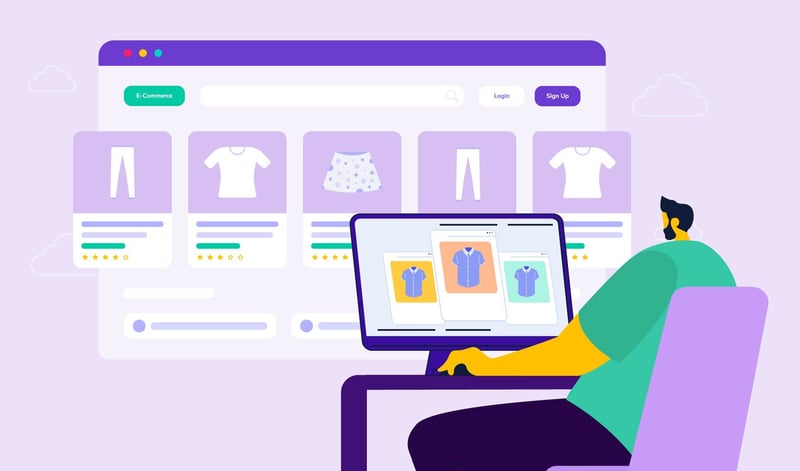Selling online means offering products people actually want to buy, and that starts with product sourcing. Sourcing product to sell online is just finding the right items, at the right price, from a reliable supplier. Pretty straight forward, right? But the way you source and what you source can make a huge difference in how successful your business is. Sourcing well means better profit margins, fewer headaches, and the ability to grow without constantly scrambling to find new inventory.
In this guide, we’ll walk through what product sourcing is, the different ways you can find products to sell online, the challenges to watch out for, and tips for beginners. By the end, you’ll have a clear idea of how to start sourcing products confidently so you can focus on building a thriving business.
Main Takeaways
- Product sourcing is the process of finding and investing in products to sell, and it directly impacts profit margins, scalability, and quality.
- Sellers have multiple sourcing options: wholesale, dropshipping, private/white label, trade shows, local suppliers, and online marketplaces.
- Apps like Spocket, DSers, Faire, and Printful connect sellers to reliable suppliers and can even automate parts of the process to help businesses run more efficiently.
- Common challenges include unreliable suppliers, high minimum orders, inconsistent quality, hidden costs, and long shipping times.
- Following best practices, like ordering samples, verifying suppliers, calculating landed costs, and diversifying sources, helps minimize risks.
- Effective sourcing builds stronger margins, better branding opportunities, reliable partnerships, and increases chances of long-term business growth.
What Exactly is Product Sourcing?
Product sourcing is the process of finding and acquiring products that you can sell in your business, whether you’re an online seller or have a brick-and-mortar shop. While it sounds relatively simple, it can include multiple steps like finding the right product and/or supplier, negotiating terms, and then securing inventory at a price that leaves enough room for profit. That inventory can come directly from a manufacturer, a distributor, a wholesaler, a retailer, or even local artisans, depending on your business.
The reason product sourcing is so important comes down to three things:
- Profit margins: Your cost of goods is the single biggest factor that decides whether your business makes a profit.
- Scalability: A reliable source allows you to restock and expand without having to spend time searching for alternatives.
- Quality Control: The right source helps maintain consistency so you don’t have to deal with defective or low-grade products.
Good sourcing isn’t always about finding the cheapest option, a mistake many new business owners make. It’s more about balancing cost, quality, and reliability so that your business can grow successfully long term.
Where to Source Products From
There isn’t one “best way” when it comes to sourcing product to sell online. It all depends on your business model, available capital, and how hands-on you want to be. Below are the most common methods for sourcing products, along with some advantages and drawbacks.
1. Wholesale Suppliers
What it is: Buying in bulk directly from wholesalers who purchase large quantities from manufacturers.
Why choose it: Wholesale is one of the most traditional and reliable ways to stock your store. You can often get lower per-unit costs, which boosts your margins, and wholesalers usually carry products that already have demand. Building relationships with wholesalers also pays off long-term! You may get early access to new products or better pricing as your orders grow.
Drawbacks: Wholesale usually requires a bigger upfront investment, plus somewhere to store all that inventory. Since wholesalers often sell to many different retailers, you will also be competing with other sellers selling the same products.
2. Dropshipping
What it is: Partnering with suppliers who ship products directly to your customers for you.
Why choose it: Dropshipping makes it easy to get started with almost no upfront cost. You don’t have to worry about storing or shipping products yourself, and you can test new ideas quickly to see what sells. This flexibility is why dropshipping is so popular for beginners.
Drawbacks: The trade-off is lower profit margins and less control. You don’t manage shipping, packaging, or inventory levels, so mistakes or delays fall back on you even if they weren’t your fault. Competition is high since many sellers source from the same dropshipping catalogs.
3. Private Label or White Label Manufacturing
What it is: Ordering products from a manufacturer and branding them as your own.
Why choose it: This is how many sellers build a recognizable brand of their own instead of selling other brands. You can take a product that already sells well, tweak it, add your logo, or package it in a way that makes it unique to your store. This lets you stand out from competitors who are only competing on price.
Drawbacks: Private label and white label sourcing often require large minimum orders and longer lead times, which can tie up cash and slow you down if you need to get profitable quickly. It’s a great long-term strategy, but it’s usually better for sellers who have some experience and capital.
4. Trade Shows
What it is: In-person events where suppliers showcase their latest products.
Why choose it: Trade shows are great for seeing products up close and meeting suppliers in person. You can ask questions, negotiate terms, and even spot trends before they’re available to everyone else. They’re also a chance to network with other sellers in your industry.
Drawbacks: Trade shows can be expensive to attend, with travel and registration costs adding up. They’re also usually industry-specific, so you’ll need to find the right events for your niche.
6. Online Marketplaces and Platforms
What it is: Platforms like Alibaba, AliExpress, Faire, etc.
Why choose it: These platforms give you access to a massive variety of products at competitive prices. It’s one of the easiest ways to connect with manufacturers and wholesalers worldwide, compare suppliers side by side, and find items that fit your niche.
Drawbacks: Long shipping times are common for international orders. Quality can vary widely between suppliers, so samples are a must when going this route. You’ll also need to stay on top of international regulations, import duties, and extra fees that come with international sourcing.
Popular Apps to Product Source
Modern technology has made sourcing products easier than it has ever been. Instead of relying on trade shows that only happen a few times a year or cold calling suppliers, online sellers can now browse thousands of vendors, compare prices, and even automate order management with apps and online platforms.
Below are some of the most widely used product sourcing apps and what they’re best used for so you can decide which might be the right fit for your e-commerce store.
Spocket
Spocket specializes in connecting sellers with U.S. and European suppliers. The biggest advantage is faster shipping when you compare to suppliers based in Asia. That way, customers get their orders faster, which is a big deal when many people are used to free two-day shipping. Many of the suppliers also allow branded invoicing, which keeps your store looking professional even if you’re dropshipping and not holding any inventory yourself.
Best for: Sellers who want faster shipping times and a more local supplier network.
DSers
DSers is the official dropshipping partner of AliExpress, one of the most popular places to source inventory. It allows you to bulk place and manage AliExpress orders in a few clicks, which can save hours of manual work. One of its best features is supplier optimization, which automatically finds the best-rated supplier for a specific product.
Best for: Sellers who want to run a high-volume dropshipping store with AliExpress products.
Faire
Faire is a wholesale marketplace for connecting retailers with independent makers and smaller brands. It’s a great option if you want more unique products that aren’t as saturated on Amazon or AliExpress. Faire also offers flexible payment terms and lower-risk minimum orders, making it easier to test new products.
Best for: Boutique-style stores that value unique products customers won’t find everywhere else.
Dropcommerce
Dropcommerce focuses on North American suppliers who often specialize in offering higher-quality goods and ethical production. Their network is smaller than AliExpress, but they prioritize suppliers who can deliver quickly and provide reliable service.
Best for: Sellers who value product quality and want to avoid the long shipping delays common with international dropshippers.
Syncee
Syncee works with suppliers around the world and offers a wide product catalog. The app also features things like AI tools and one-click import to your store in bulk, and more.
Best for: Sellers who want to have a large catalog of products and who want automated pricing and bulk product management.
Printful & Gelato
Both Printful and Gelato specialize in print-on-demand products, which allow you to offer customized items like apparel, mugs, posters, and stationery. Printful is widely known for its easy integrations and high-quality printing, while Gelato focuses on more localized production, which reduces shipping costs and delivery times.
Best for: Creators who want to sell custom merchandise without handling inventory or printing it themselves.
Remember, these products don’t eliminate all risk of product sourcing, and it’s still important to order samples, check supplier reliability, and watch costs, but they do dramatically shorten the learning curve and time spent sourcing products.
Challenges when Sourcing Products
While sourcing products is easier than ever due to technology, that doesn’t mean it’s not without its challenges. Understanding these challenges upfront can help you avoid common mistakes and make smarter decisions from the start.
Unreliable Suppliers
Not every supplier is consistent. Some may ship late, provide products that don’t match the listing, or stop responding when problems come up. If orders show up late or products don’t match what was promised, your reputation can take a hit.
Tip: Always order samples before committing to large orders, and try to keep notes on how responsive the supplier is during the process.
High Minimum Order Quantities (MOQs)
Many manufacturers and wholesalers require you to buy in bulk to purchase their products, especially if you want a good price. While bulk buying lowers the per-unit cost, it can be a big risk for beginners who don’t know how well a product will sell.
Tip: Look for suppliers with smaller MOQs, or start with a sourcing app that allows single-unit purchases (like dropshipping) until you’re ready to scale.
Inconsistent Product Quality
Even if the first batch looks perfect, later shipments might not match. Small changes in materials or production can lead to disappointed customers and unwanted returns.
Tip: Test every new batch with sample orders and communicate clear quality expectations in writing.
Hidden Costs
The advertised price of a product isn’t the full story. Shipping fees, customs duties, packaging, and transaction charges can add up really quickly if you don’t pay attention. Failing to factor these in can eat away at your profit margin.
Tip: Calculate the landed cost (product + shipping + duties + fees) before deciding whether an item is worth selling.
Long Shipping Times
When sourcing from overseas, delivery can take weeks or even months. When buying to stock your store, this can mean a trend or season has passed. With dropshipping, this frustrates customers who are used to quick shipping from platforms like Amazon.
Tip: Balance overseas suppliers with domestic ones when possible. Also, make sure you’re transparent with customers about expected delivery times.
Best Practices when Product Sourcing
Starting with the right approach and mindset can turn product sourcing from overwhelming to manageable. Use this quick checklist to make sure you’re covering the most important steps when sourcing product to sell online.
Always Order Samples First
It’s tempting to skip samples to save time or money, but it’s one of the biggest mistakes beginners make. A sample tells you almost everything you need to know: quality, packaging, how fast it ships, and even how the supplier communicates. It’s better to discover issues on a $20 sample order than after you’ve invested hundreds (or thousands) in bulk inventory.
Verify Supplier Credentials
Not all suppliers are equal. Some are established, reliable businesses, while others might be brand new or even misleading about what they can deliver. Research how long they’ve been in business, check buyer reviews, and ask for credentials like business licenses or certifications (if applicable). Even a simple Google search of their company name plus “reviews” could save you from a bad supplier!
Start Small, Then Scale
Jumping into a big order feels efficient, but it’s risky. Instead, begin with the smallest order the supplier allows. This lets you test product quality and see if customers actually want what you’re selling. Once you know a product is moving, you can increase your order size, which usually brings better pricing.
Diversify Suppliers
One supplier is fine until something goes wrong. Taking the time to vet backup suppliers for your products protects you against delays, shortages, or changes in pricing. It may require a little more work upfront, but you’ll be thankful to have another supplier ready if your main supplier is no longer available to supply your best-selling product.
Negotiate Clear Terms Upfront
Always ask about minimum order quantities, payment terms, and refund or replacement policies. Make sure to get everything in writing so there’s no confusion later if a problem comes up. This also shows the supplier you’re serious and professional, which can lead to better service.
Calculate the Landed Cost
Don’t make the mistake of relying on the per-unit price to calculate profitability. Factor in the full cost of a product, including shipping, customs duties, packaging, and platform fees. If you don’t factor these in, you could end up selling items at a loss without even realizing it. Always do the math before committing.
Pay Attention to Communication
A supplier’s communication style tells you a lot. Suppliers who respond quickly and clearly are more likely to be reliable partners. Slow or inconsistent communication can be a red flag.
Benefits to Product Sourcing
While the process takes time and patience, effective product sourcing can pay off in ways that go far beyond filling your store with inventory.
Better Profit Margins
Finding the right supplier at the right price gives you room to grow your business in a way that’s sustainable. For example, a small savings of less than a dollar per unit adds up quickly once you start selling at volume.
More Variety for Your Customers
Good sourcing gives you access to products that help your store stand out. You can bring in fresh products that keep your shop exciting and make your customers want to come back for more.
Branding Opportunities
One thing a lot of sellers overlook is that private label or white label sourcing allows you to build a brand around your products instead of competing only on price. This kind of control over your store's offerings is what turns a side hustle into a long-term business.
Reliable Partnerships
When you build trust with suppliers, you deal with fewer surprises and headaches. Over time, you’ll have partners who understand your needs, prioritize your orders, and help you stay ahead of demand.
Scaling Opportunities
With the right sourcing systems in place, your business becomes easier to grow. Instead of constantly hunting for new suppliers, which can take a lot of time and money, you can focus on marketing, customer experience, and long-term strategy.
Success Begins with Sourcing
At the end of the day, every successful online business is built on smart product sourcing. When you take the time to find reliable suppliers, test products to ensure quality, and understand your true costs, you set yourself up for more profit, less stress, and a business that can grow steadily.
Whether you’re starting with dropshipping, experimenting with wholesale, or building your own private label brand, sourcing product to sell online is the one key that makes everything else possible
Sourcing Products to Sell Online FAQs
What is the meaning of product sourcing?
Product sourcing is the process of finding and purchasing products to sell online or in stores. It can involve working with manufacturers, wholesalers, distributors, or suppliers to secure items at a price that allows for profit while maintaining quality and reliability.
What is an example of sourcing a product?
An example of sourcing a product is buying phone cases in bulk from a manufacturer on Alibaba, then reselling them in your online store. Other examples include using a dropshipping supplier to ship items directly to customers or partnering with a local artisan to sell handmade goods.
What are the 4 pillars of sourcing?
The four pillars of sourcing typically include cost, quality, reliability, and speed. These factors help evaluate whether a supplier can provide affordable products, maintain consistent standards, deliver on time, and support the growth of your business without unexpected issues.
How to source a product to sell?
When sourcing product to sell online, start by researching demand and competition, then choose a supplier that fits your budget and goals. Order samples to test quality, negotiate terms, and calculate the full landed cost. Beginners often start with dropshipping or small wholesale orders to reduce risk.
What is the best way to source products for ecommerce?
The best way depends on your budget and goals. Beginners often start with dropshipping to test products without upfront inventory costs. As you grow, wholesale or private label sourcing usually offers better profit margins and control. The key is balancing cost, reliability, and product quality.
What is the difference between wholesale and dropshipping?
With wholesale, you buy products in bulk upfront, store them, and handle shipping to customers. This usually gives higher profit margins but requires more investment. Dropshipping, on the other hand, means suppliers ship directly to your customers, reducing upfront costs but often lowering margins and limiting control.







